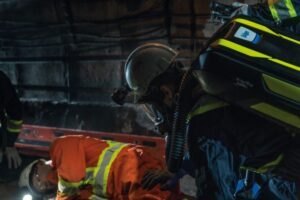Dräger calls for improved safety in tunnelling industry
SHP hears from Dräger, a medical and safety technologies company, who is calling for increased regulation and more detailed safety guidance within the tunnelling industry, following recent research highlighting safety as a major concern for those working underground…
 The survey gathers a range of perspectives from tunnelling professionals to find out how safety challenges are perceived, and to what extent solutions are considered beneficial, practical and appropriate for the distinct environments found in tunnelling.
The survey gathers a range of perspectives from tunnelling professionals to find out how safety challenges are perceived, and to what extent solutions are considered beneficial, practical and appropriate for the distinct environments found in tunnelling.
The research revealed that the four highest perceived risks were the availability of safety equipment, gas/vapour leaks, the time taken to evacuate a tunnel, and a lack of robust and up-to-date safety plans. These concerns were ranked higher than issues such as the structural integrity of tunnels and working within confined spaces.
Further compounding the issue, just 14.8% believed that all contractors on site had a thorough understanding of safety planning, and more than two in five (40.7%) respondents said they did not think enough priority was given to safety planning in tunnelling projects. Budget and time constraints were cited as reasons, along with the belief that because tunnelling accidents are ‘rare’, safety planning wasn’t always prioritised.
The research suggests accidents are in fact ‘relatively common’, as nearly one in three (29.6%) of respondents had been involved in a safety incident while working in a tunnel that required the use of safety equipment, and a further 59.0% stated that they had been involved in a near-miss incident in the same environment.
Sarah Sanderson, tunnelling product specialist at Dräger, says that these statistics, while alarming, are not a surprise: “Tunnelling environments can be extremely hazardous, with a variety of different machinery being used within a confined space, often at the same time. Indeed, we have heard of global projects where stakeholders have been extremely relieved when there have been no major incidents after a year.
“The fact that these incidents are relatively common goes to show that serious accidents are not that rare, and safety equipment and planning should not be considered a ‘nice to have’, but deemed critical and essential.”
An overwhelming majority of the sample stated safety equipment being damaged or lost was commonplace, with 44.4% of respondents stating it was necessary to be replaced in every project, 25.9% answering replacement was needed in most projects, and a further 25.9% claiming that it was occasionally required.
While traceability and asset registers are generally in place to mitigate and manage issues concerning lost and damaged kit, more than one in ten (11.1%) of respondents were not aware of these registers, and nearly half (48.2%) did not know whether recent projects had had one in place.
“It is our industry’s responsibility to keep tunnelling personnel as safe as possible at all times,” adds Sarah. “Detailed safety and rescue strategies must be planned, coordinated and agreed across all interest groups – and indeed supported by thorough and dedicated regulation.”
Hosted by the Tunnelling Journal, the average number of years served in personnel in the tunnelling industry by respondents was 22.9 years, with more than a third (34.0%) of respondents serving for more than 30 years.
Dräger calls for improved safety in tunnelling industry
SHP hears from Dräger who is calling for increased regulation and more detailed safety guidance within the tunnelling industry.
Safety & Health Practitioner
SHP - Health and Safety News, Legislation, PPE, CPD and Resources Related Topics
Housing company fined more than £500k after worker suffers burns
SHP weekly top five
Company fined as worker has leg amputated

 The survey gathers a range of perspectives from tunnelling professionals to find out how safety challenges are perceived, and to what extent solutions are considered beneficial, practical and appropriate for the distinct environments found in tunnelling.
The survey gathers a range of perspectives from tunnelling professionals to find out how safety challenges are perceived, and to what extent solutions are considered beneficial, practical and appropriate for the distinct environments found in tunnelling.